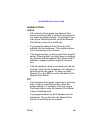OkiLAN 6200e Plus User’s Guide
TCP/IP 142
do not know their IP address. When powering up on a
network, a device that uses RARP broadcasts its net-
work hardware address in a RARP request message.
A RARP server (which may be a UNIX workstation)
responds with an IP address. The device then knows
its IP address and use this address to perform subse-
quent TCP/IP transactions.
Note: Once the Network Print Server has been
assigned an IP address, the Network Print Server
configuration utility (which is accessed by telnet-
ing to the Network Print Server) or OkiNet for TCP/
IP allows you to change and/or make the IP
address permanent. This means that a RARP
server needs to be available only during installa-
tion of the Network Print Server.
Address Formats
Network hardware addresses are 48-bits and are
expressed in 6 bytes in hexadecimal format usually
separated by colons. Each hexadecimal byte has a
range from 00 to FF.
Example: 00:02:16:17:50:A4
IP addresses are 32-bits and are expressed in 4 bytes
in decimal format usually separated by periods. Each
decimal byte has a range from 0 to 255.
Example: 192:168:42:55
Configuration Files
The purpose of RARP is to look up a 32-bit IP address
given a 48-bit network hardware address. The RARP
server (which is usually a UNIX workstation running a
rarpd daemon) performs this function using two config-
uration files and one or more daemons. The configura-
tion files are “/etc/hosts” and “/etc/ethers” and the


















